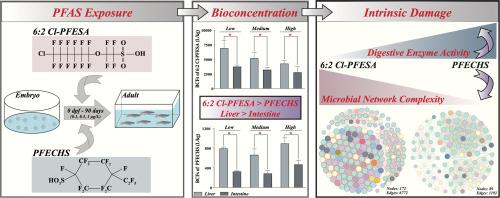Emerging per- and polyfluoroalkyl substances (PFAS) cause intestinal toxicity in marine medaka (Oryzias melastigma)
IF 4.3
2区 环境科学与生态学
Q1 MARINE & FRESHWATER BIOLOGY
引用次数: 0
Abstract
Perfluoroethylcyclohexane sulfonate (PFECHS) and 6:2 chlorinated polyfluoroalkyl ether sulfonate (6:2 Cl-PFESA) are emerging per- and polyfluoroalkyl substances (PFAS) of growing concern due to their frequent detection in coastal environments and bioaccumulation in marine biota. Given structural similarities to legacy PFAS, it is hypothesized that these emerging PFAS may induce toxic effects on the digestive system in vivo. This study investigated the bioavailability and potential digestive damage of PFECHS and 6:2 Cl-PFESA using marine medaka (Oryzias melastigma) as a model animal. Fish were chronically exposed (90 days post-fertilization) to PFECHS and 6:2 Cl-PFESA at environmentally relevant concentrations (nominal: 0.1, 0.3, and 1.0 μg/L). Results demonstrated that 6:2 Cl-PFESA had a higher bioconcentration potential than PFECHS, and both emerging PFAS preferred accumulating in liver over intestines. PFECHS exposure caused alterations in intestinal digestive enzyme activities and substantial changes in intestinal microbial community in medaka. Compared with the 6:2 Cl-PFESA-exposure and control groups, PFECHS exposure decreased the relative abundance of beneficial bacteria (e.g., Bacteroides and Pseudomonas), while increased the relative abundance of Alkalimarinus and pathogenic bacteria Vibrio. Co-occurrence network analysis further revealed species interactions were less complex and cooperative in medaka exposed to PFECHS than 6:2 Cl-PFESA. These findings provide critical evidence for the toxic mechanisms of these emerging PFAS regarding their disruption of intestinal homeostasis, enzymatic function, and microbial symbiosis in marine fish.

新出现的全氟烷基和多氟烷基物质(PFAS)引起海洋medaka (Oryzias melastigma)肠道毒性。
全氟乙基环己烷磺酸盐(PFECHS)和6:2氯化多氟烷基醚磺酸盐(6:2 Cl-PFESA)是新兴的单氟烷基和多氟烷基物质(PFAS),由于它们在沿海环境中经常被检测到,并且在海洋生物群中有生物积累,因此日益受到关注。鉴于与传统PFAS的结构相似性,假设这些新出现的PFAS可能会对体内消化系统产生毒性作用。本研究以海洋medaka (Oryzias melastigma)为模型动物,研究PFECHS和6:2 Cl-PFESA的生物利用度和潜在的消化损伤。鱼在受精后90天长期暴露于PFECHS和6:2 Cl-PFESA环境相关浓度(名义浓度:0.1、0.3和1.0 μg/L)。结果表明,6:2 Cl-PFESA比PFECHS具有更高的生物富集潜力,并且两种新出现的PFAS都倾向于在肝脏而不是肠道中积累。pechs暴露引起了medaka肠道消化酶活性的改变和肠道微生物群落的实质性变化。与6:2 cl - pechs暴露组和对照组相比,pechs暴露降低了有益菌(如拟杆菌和假单胞菌)的相对丰度,而增加了碱毒杆菌和致病菌弧菌的相对丰度。共现网络分析进一步表明,与6:2 Cl-PFESA相比,接触PFECHS的藻属物种间的相互作用更为复杂和合作。这些发现为这些新出现的PFAS的毒性机制提供了关键证据,这些机制涉及它们对肠道稳态、酶功能和海洋鱼类微生物共生的破坏。
本文章由计算机程序翻译,如有差异,请以英文原文为准。
求助全文
约1分钟内获得全文
求助全文
来源期刊

Aquatic Toxicology
环境科学-毒理学
CiteScore
7.10
自引率
4.40%
发文量
250
审稿时长
56 days
期刊介绍:
Aquatic Toxicology publishes significant contributions that increase the understanding of the impact of harmful substances (including natural and synthetic chemicals) on aquatic organisms and ecosystems.
Aquatic Toxicology considers both laboratory and field studies with a focus on marine/ freshwater environments. We strive to attract high quality original scientific papers, critical reviews and expert opinion papers in the following areas: Effects of harmful substances on molecular, cellular, sub-organismal, organismal, population, community, and ecosystem level; Toxic Mechanisms; Genetic disturbances, transgenerational effects, behavioral and adaptive responses; Impacts of harmful substances on structure, function of and services provided by aquatic ecosystems; Mixture toxicity assessment; Statistical approaches to predict exposure to and hazards of contaminants
The journal also considers manuscripts in other areas, such as the development of innovative concepts, approaches, and methodologies, which promote the wider application of toxicological datasets to the protection of aquatic environments and inform ecological risk assessments and decision making by relevant authorities.
 求助内容:
求助内容: 应助结果提醒方式:
应助结果提醒方式:


